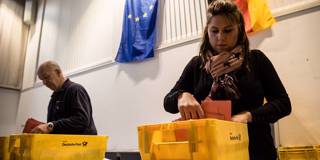With voter turnout in European elections at historic lows, populist and anti-establishment parties are hoping to win outsize parliamentary representation later this month. Like the Trump campaign in the 2016 US presidential election, they will focus on suppressing turnout among key constituencies and mobilizing their own base.
STOCKHOLM – European voter turnout is in deep crisis. Since the early 2000s, the share of voters in national elections has fallen to 66% on average, which means that the birthplace of democracy now ranks below average globally. The situation is even worse in European Parliament elections: in 2014, turnout was 42.6%, almost 20 points below what it was in 1979. Only in countries with compulsory voting, such as Belgium and Luxembourg, has turnout remained high.

STOCKHOLM – European voter turnout is in deep crisis. Since the early 2000s, the share of voters in national elections has fallen to 66% on average, which means that the birthplace of democracy now ranks below average globally. The situation is even worse in European Parliament elections: in 2014, turnout was 42.6%, almost 20 points below what it was in 1979. Only in countries with compulsory voting, such as Belgium and Luxembourg, has turnout remained high.